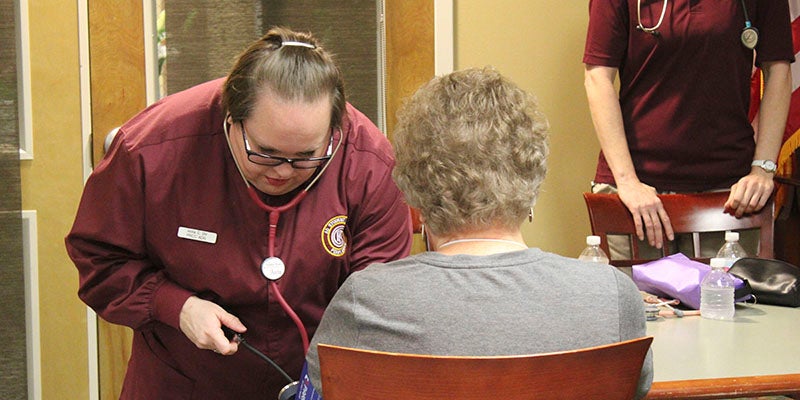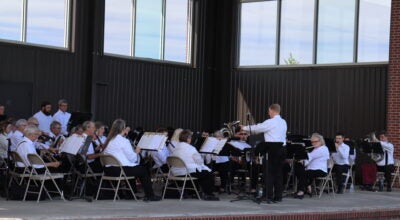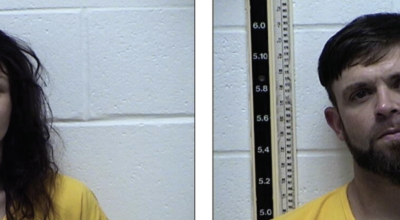Medical classes adapt to pandemic related social distancing
Published 7:00 am Tuesday, May 5, 2020

- Experience: A nursing student checks a volunteer’s blood pressure during the most recent Women’s Health Symposium held at Pearl River Community College. With the college closed due tot he pandemic, nursing and other medical students have to gain hands on experience through other means. File photo by Cathy Cook | Picayune Item
Despite the transition to distance and online learning, students in medical programs at Pearl River Community College are still able to finish the semester by engaging with hands on learning at home instead of in a clinic.
The college has 10 different medical programs, including registered nursing, radiology technology and physical therapy assistant.
Clinical sites are the best avenue for students to learn, said Vice-President for Forrest County Operations Dr. Jana Causey, but with the pandemic students were unable to continue working in medical clinics or hospitals.
When possible, students used virtual material or high tech simulations on campus, but for some students getting hands on experience was a bigger challenge, said Causey. Teachers are using video calls and YouTube to demonstrate skills and to see their students practicing those skills.
Moving classes online has been a big learning curve for students and faculty, said Dr. Arlene Jones, director of the associate degree nursing program.
Dental hygiene students typically work in a dental clinic at the Forrest County campus, which had to stop seeing patients due to the pandemic. However, faculty and staff are allowing students to clean their teeth to help students finish the semester, Causey said.
Students in the nursing program have used family members as practice patients, checking them for vital signs or pretending a family member had symptoms they needed to practice with, said Jones.
The nursing department had a simulation program for several years, which is being heavily relied on to help students finish the semester, said Causey. Students can practice virtual x-rays and using a microscope virtually, said Causey.
The lab simulations on campus mimic a hospital setting and use high tech mannequins to mimic a patient, said Causey. The mannequins have a heart beat, blood pressure and symptoms a patient might display.
“I would say the biggest difference in the lab simulation and the actual hospital would be the social aspect of dealing with that patient. The one thing that you probably miss in the mannequins is all the different emotions and things that a patient would experience when they’re in pain,” said Causey.
One of the challenges in the physical therapist assistant program is learning how to measure a joint’s range of motion, said teacher Dr. Tracie Thornton.
In physical therapy, the range of motion is measured to help show patient progress after an injury. However, students did not have the tool they’d need, a goniometer, to measure that range of motion, so Thornton emailed them a pattern to create one out of paper. One student took the task a step farther and constructed one out of wood.
Most students practiced on family or roommates, but one student who lived alone built their own patient. The student used vinyl siding and string to create a faux leg that they could practice measuring a joint’s range of motion.
Thornton said she was amazed by the student’s critical thinking skills and creativity.
“As we encounter challenges, instead of me trying to solve everything, I really got (students’) input because they are so innovative and creative,” said Thornton. “They have actually been a very important part of this transition to this online format.”
Since the college did not have to transition to distance learning until after spring break, many students had completed most of their clinical time, said Causey.
“These students are not going to miss out on a ton of the clinical experience,” said Causey. “We’re basically fine tuning their skills at this point in the lab check off to reach their final skills and finish them.”
Causey said she believes the medical programs will be prepared to teach students if more distance learning is necessary in the fall. If necessary, the nursing program does have enough classrooms to keep students in small groups during class in the fall, said Jones.
Students have not voiced any hesitations about entering the medical field during a pandemic, said Jones.
“If anything I think it’s made them want to help people even more,” said Thornton. “It’s made them even more passionate about going into healthcare.”
All 22 of the second year physical therapy assistant students should graduate, said Thornton. The nursing program is graduating 51 new nurses this spring and has a new group of 60 nursing students entering the program in the fall, said Jones.





